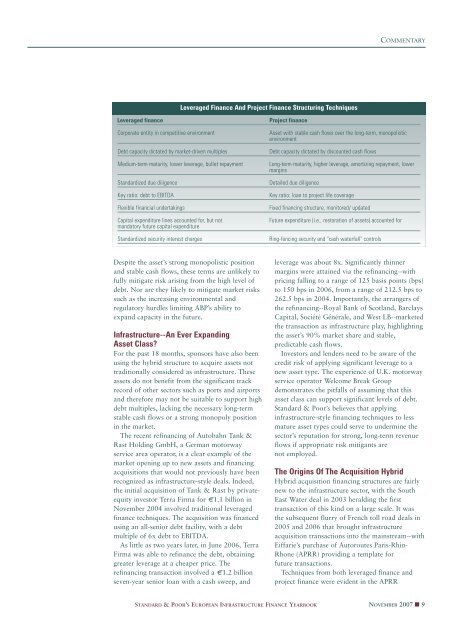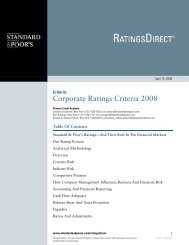European Infrastructure Finance Yearbook - Investing In Bonds ...
European Infrastructure Finance Yearbook - Investing In Bonds ...
European Infrastructure Finance Yearbook - Investing In Bonds ...
You also want an ePaper? Increase the reach of your titles
YUMPU automatically turns print PDFs into web optimized ePapers that Google loves.
Leveraged <strong>Finance</strong> And Project <strong>Finance</strong> Structuring Techniques<br />
Leveraged finance Project finance<br />
Despite the asset’s strong monopolistic position<br />
and stable cash flows, these terms are unlikely to<br />
fully mitigate risk arising from the high level of<br />
debt. Nor are they likely to mitigate market risks<br />
such as the increasing environmental and<br />
regulatory hurdles limiting ABP’s ability to<br />
expand capacity in the future.<br />
<strong><strong>In</strong>frastructure</strong>--An Ever Expanding<br />
Asset Class?<br />
For the past 18 months, sponsors have also been<br />
using the hybrid structure to acquire assets not<br />
traditionally considered as infrastructure. These<br />
assets do not benefit from the significant track<br />
record of other sectors such as ports and airports<br />
and therefore may not be suitable to support high<br />
debt multiples, lacking the necessary long-term<br />
stable cash flows or a strong monopoly position<br />
in the market.<br />
The recent refinancing of Autobahn Tank &<br />
Rast Holding GmbH, a German motorway<br />
service area operator, is a clear example of the<br />
market opening up to new assets and financing<br />
acquisitions that would not previously have been<br />
recognized as infrastructure-style deals. <strong>In</strong>deed,<br />
the initial acquisition of Tank & Rast by privateequity<br />
investor Terra Firma for €1.1 billion in<br />
November 2004 involved traditional leveraged<br />
finance techniques. The acquisition was financed<br />
using an all-senior debt facility, with a debt<br />
multiple of 6x debt to EBITDA.<br />
As little as two years later, in June 2006, Terra<br />
Firma was able to refinance the debt, obtaining<br />
greater leverage at a cheaper price. The<br />
refinancing transaction involved a €1.2 billion<br />
seven-year senior loan with a cash sweep, and<br />
COMMENTARY<br />
Corporate entity in competitive environment Asset with stable cash flows over the long-term, monopolistic<br />
environment<br />
Debt capacity dictated by market-driven multiples Debt capacity dictated by discounted cash flows<br />
Medium-term maturity, lower leverage, bullet repayment Long-term maturity, higher leverage, amortizing repayment, lower<br />
margins<br />
Standardized due diligence Detailed due diligence<br />
Key ratio: debt to EBITDA Key ratio: loan to project life coverage<br />
Flexible financial undertakings Fixed financing structure, monitored/ updated<br />
Capital expenditure lines accounted for, but not Future expenditure (i.e., restoration of assets) accounted for<br />
mandatory future capital expenditure<br />
Standardized security interest charges Ring-fencing security and "cash waterfall" controls<br />
leverage was about 8x. Significantly thinner<br />
margins were attained via the refinancing--with<br />
pricing falling to a range of 125 basis points (bps)<br />
to 150 bps in 2006, from a range of 212.5 bps to<br />
262.5 bps in 2004. Importantly, the arrangers of<br />
the refinancing--Royal Bank of Scotland, Barclays<br />
Capital, Société Générale, and West LB--marketed<br />
the transaction as infrastructure play, highlighting<br />
the asset’s 90% market share and stable,<br />
predictable cash flows.<br />
<strong>In</strong>vestors and lenders need to be aware of the<br />
credit risk of applying significant leverage to a<br />
new asset type. The experience of U.K. motorway<br />
service operator Welcome Break Group<br />
demonstrates the pitfalls of assuming that this<br />
asset class can support significant levels of debt.<br />
Standard & Poor’s believes that applying<br />
infrastructure-style financing techniques to less<br />
mature asset types could serve to undermine the<br />
sector’s reputation for strong, long-term revenue<br />
flows if appropriate risk mitigants are<br />
not employed.<br />
The Origins Of The Acquisition Hybrid<br />
Hybrid acquisition financing structures are fairly<br />
new to the infrastructure sector, with the South<br />
East Water deal in 2003 heralding the first<br />
transaction of this kind on a large scale. It was<br />
the subsequent flurry of French toll road deals in<br />
2005 and 2006 that brought infrastructure<br />
acquisition transactions into the mainstream--with<br />
Eiffarie’s purchase of Autoroutes Paris-Rhin-<br />
Rhone (APRR) providing a template for<br />
future transactions.<br />
Techniques from both leveraged finance and<br />
project finance were evident in the APRR<br />
STANDARD & POOR’S EUROPEAN INFRASTRUCTURE FINANCE YEARBOOK NOVEMBER 2007 ■ 9



